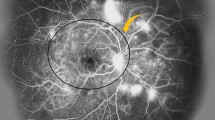Abstract
Panretinal photocoagulation (PRP) uses light energy to create thermal injury to the retinal tissue. When PRP is applied to areas of poorly perfused retina, pathologic levels of vascular endothelial growth factor (VEGF) are suppressed. PRP is an effective method of treating ischemic retinal vascular disease such as proliferative diabetic retinopathy (PDR). Fluorescein angiography should be performed to identify areas of neovascularization and retinal ischemia to guide application of PRP. A clear view of the fundus facilitates delivery of PRP. Effective delivery of PRP may be limited or delayed if the ocular media is obscured by corneal edema, cataract, and/or vitreous hemorrhage.
Access provided by CONRICYT-eBooks. Download chapter PDF
Similar content being viewed by others
Keywords
- Diabetic retinopathy
- Venous occlusive disease
- Central retinal vein occlusion
- Ischemic retina
- Threshold retinopathy of prematurity
- Photocoagulation
Indications
-
Diabetic retinopathy, central retinal vein occlusion, ischemic retina, sickle cell retinopathy, and neovascularization
Essential Steps
-
1.
Topical anesthetic and dilating drops.
-
2.
(Optional—Anesthetic injection (retrobulbar, peribulbar, or sub-Tenon’s space) is given if the patient cannot tolerate discomfort of laser burns.)
-
3.
With slit-lamp delivery system:
-
(a)
Place additional topical anesthetic drops.
-
(b)
Special contact lens is coupled with ophthalmic gel (i.e., topical glycerin).
-
(c)
Position patient comfortably in front of slit lamp.
-
(d)
Ensure proper slit-lamp laser equipment and laser settings.
-
(a)
-
4.
With indirect laser system:
-
(a)
Position patient comfortably
-
(b)
Ensure proper setup of laser indirect ophthalmoscope with appropriate laser settings
-
(a)
-
5.
Apply laser and adjust exposure settings to appropriate retinal response.
-
6.
Adjust anesthesia following initiation of treatment as necessary.
Complications
-
Transient vision loss
-
Photocoagulation of the fovea
-
Macular edema
-
Hemorrhage
-
Choroidal effusions
-
Visual field defects
-
Night vision problems
Template Operative Dictation
Preoperative diagnosis: Proliferative diabetic retinopathy (OD/OS)
Procedure: (1) Panretinal photocoagulation (OD/OS)
Postoperative diagnosis: Same
Indication: Patient is a ____-year-old (male/female) who has proliferative diabetic retinopathy. The risks, benefits, and alternatives and purpose of laser treatment were discussed with the patient. The patient expressed understanding that the laser treatment is performed not to improve vision but to stabilize vision and prevent further vision loss. The patient understood (his/her) clinical diagnosis, including the risks of the procedure and anesthesia risks including vision loss, need for further laser treatments, and need for future surgery. After detailed informed consent process, the patient elected to proceed with the surgery.
Complications: (list here if applicable, otherwise: none)
Description of the procedure: A time-out procedure was carried out in the standard fashion verifying operative eye and procedures to be performed.
[Choose one]:
If topical anesthesia — Proparacaine was placed into the (right/left) eye, followed by pupillary dilation with tropicamide 1 % and phenylephrine 2.5 %.
If retrobulbar/peribulbar anesthesia —__ cm 3 of 2 % lidocaine /0.75 % Marcaine was injected into the (right/left) (retrobulbar/peribulbar) space, using a retrobulbar needle on a 10 cm 3 syringe.
Adequate anesthesia was obtained. Using the (green or yellow diode) laser, laser burns were applied one spot width apart, remaining one disk diameter from the disk and two disk diameters from the fovea to the retinal periphery. Laser treatment was performed without complication. The following settings and parameters were used:
-
Laser: ___________
-
Lens: ____________
-
Settings:
-
Duration: ______ ms
-
Spot size: ______ μm
-
Power: _________ mW
-
Number of spots: _________
The patient tolerated the procedure well and left the laser suite in good condition.
Author information
Authors and Affiliations
Corresponding author
Editor information
Editors and Affiliations
Rights and permissions
Copyright information
© 2017 Springer International Publishing Switzerland
About this chapter
Cite this chapter
Lee, J., Rosen, R. (2017). Panretinal Photocoagulation (PRP). In: Rosenberg, E., Nattis, A., Nattis, R. (eds) Operative Dictations in Ophthalmology. Springer, Cham. https://doi.org/10.1007/978-3-319-45495-5_59
Download citation
DOI: https://doi.org/10.1007/978-3-319-45495-5_59
Published:
Publisher Name: Springer, Cham
Print ISBN: 978-3-319-45494-8
Online ISBN: 978-3-319-45495-5
eBook Packages: MedicineMedicine (R0)




